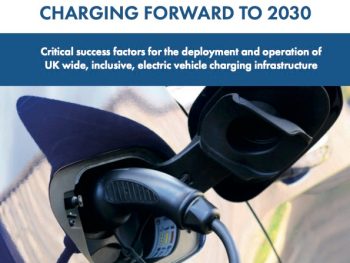Recharge UK report sets out critical success factors for EV charging
Electric vehicle trade group Recharge UK has published a roadmap of how the sector can accelerate charge point deployment to keep up with the growth of EV sales.

The report sets out a pathway which identifies where necessary changes to policy and regulation are required to accelerate charge point deployment
The report sets out key recommendations while also providing insights into which parts of the UK are likely to see high levels of public charging demand to support distribution network operators (DNOs) and National Grid with additional data. It also calls for more joined-up thinking between stakeholders involved in accelerating the transition to clean energy and transport – and stresses the need for action at a local level but also with leadership from national and devolved governments.
The report has developed a pathway which identifies where necessary changes to policy and regulation are required to accelerate charge point deployment and ensure charging plans are smarter, to meet 2030 requirements.
Recharge UK, which is the EV arm of the REA (Association for Renewable Energy and Clean Technology), sets out how to accelerate the rollout of EV charging by breaking down the policy and regulatory barriers to charge point deployment and meet the energy demand on the grid by 2030 from public charging.
There are currently over 40,000 public EV charge points in the UK, serving around 2% of vehicles on the road, but this will need to fast expand.
In May 2023, EVs made up some 17% of new car sales but following the introduction of the ZEV mandate in 2024, this could rise to as much as 80% of new car sales and 70% of new van sales by 2030, rising to 100% of both by 2035. This means there will be approximately 11 million EVs on the road by 2030, up from 760,000 today.
As well as highlighting the areas likely to see the highest energy demand, the report calls for EV infrastructure specific solutions to resolve geographic inequality in charge point deployment.
Report conclusions and recommendations include
- Ensure that regions and local authorities have the grid capacity to support EV charging demand.
- Ensure the local grid is supported by flexibility through battery storage, solar and V2X.
- Break down the policy and regulatory barriers which currently add significant cost and time to charge point deployment.
- A skills campaign must be created by Government to promote green skills and encourage more electrical engineers and installers to fill the skills gaps that will emerge by 2030.
- Industry should develop a van standard to ensure commercial fleets and van drivers are able to use public charging infrastructure easily and so local authorities can easily enable this.
- The Government should mandate accessibility and safety requirements at all public charging locations where feasible.
- Consider the different use cases for a charge point and ensure they are flexible in design and accessible to support greater utilisation by different use cases.
Matthew Adams, transport policy manager at the REA, said: “Providing stakeholders across the EV landscape with a clear roadmap on how we can accelerate charge point deployment in time for the end of sale of new petrol and diesel vehicles in 2030 is vital.
“I am delighted we are able to highlight the clear need for more focus on areas outside of London and the South East in this report and how local authorities, Ofgem, DNOs, charge point operators, political parties and government can contribute positively to charge point rollout and improve utilisation.
“Our key goal now is to promote these findings with stakeholders across Great Britain to engage with local authorities and devolved powers and discuss how they can overcome their unique barriers to charge point delivery and management.”
The report was produced with the support of Chargesafe Field Dynamics, GreenFlux, Syzygy Consulting, Trojan Energy and Zapmap.
Melanie Shufflebotham, COO and co-founder of Zapmap, welcomed the arrival of the publication, saying: “This new report does a great job of summarising the critical issues, from the cross-industry collaboration needed across planning and electricity supply to the green skills gaps we need to address.
“Crucially, it forecasts the amount of energy we will need for public charging by 2030 and 2050, and highlights the broad regional distribution of chargers that will be needed. It is vital reading for anyone working on the shift to electric vehicles.”
The full report is available at: https://www.r-e-a.net/resources/rea-ev-infrastructure-report/












